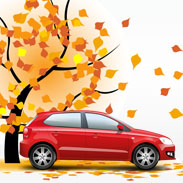Your commute home will be extra risky over the next two weeks, as drivers adjust to the end of daylight savings time and changes in their sleeping patterns and driving conditions.
The Insurance Corporation of BC historically sees a 16 per cent increase in the average number of crashes in B.C. during the late afternoon commute in the two weeks following the end of Daylight Savings Time, compared to the two weeks prior to the change.
The biggest impacts can be felt on some of the key skills that affect the quality of our driving – concentration, alertness behind the wheel and reaction time to potential hazards.
“Safety is our top priority, which is why we’re asking drivers to recognize that the effect of the time change combined with increasingly challenging road conditions can increase your chances of being in a crash,” said Todd Stone, the BC Minister of Transportation and Infrastructure. “Make sure you’re well rested, give yourself plenty of time and focus your full attention on the road.”
“Drowsy driving is actually one of the leading causes [of accidents] in North America. It’s very much akin to regular impairment,” said Liz Peters of CAA Manitoba. “It’s like drinking and driving. You’re not focusing on the road in front of you.”
While the fall time change means we can get an extra hour of sleep, according to an ICBC survey, 30 per cent of drivers overcompensate for that extra hour by staying up later and therefore losing any potential benefit of the extra rest.
“We rationalize that extra hour of sleep – many of us think that we can stay awake longer, but we actually end up feeling more tired and less alert,” said Dr. John Vavrik, a psychologist with ICBC. “The time change is an opportunity to get some extra rest and it’s also a good time to think about how we can adjust our driving to the fall and winter road conditions.”
Another study from two researchers at Carnegie Mellon University in Pittsburgh in 2007, found that daylight time has a significant impact on the number of pedestrians killed by vehicles in the immediate aftermath of the time switch in the fall.
People walking during rush hour in the first few weeks after the clocks fall back in the autumn were more than three times as likely to be fatally struck by cars than before the change. There was no significant difference at noon, but there was around 6 p.m.
Here are some tips from ICBC to help you adjust to the time change:
- In darker, poor conditions, visibility is significantly reduced making it difficult to see pedestrians and cyclists on our roads. That’s why it’s important to give yourself extra time so you aren’t rushing and adjust your speed to the conditions you encounter. Always be on the lookout for pedestrians and cyclists – especially at intersections and near transit stops where pedestrians will be coming and going and may not use crosswalks.
- Prepare your vehicle for the change in weather. Clean your vehicle’s headlights and check that they’re all working properly, especially your rear lights. Make sure you have enough windshield wiper fluid and that your wipers are in good condition.
- Keep your regular sleep/wake cycle. Go to bed at the same time you normally would so you can benefit from that extra hour of sleep. Don’t assume you are more rested and alert on the road the mornings following the change as the time change can impact the quality of your sleep and affect your body’s internal clock.
ILScorp now offers two new ICBC Autoplan courses for BC insurance agents.




